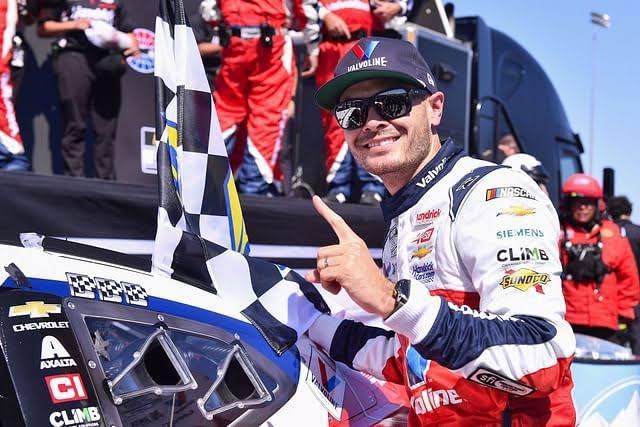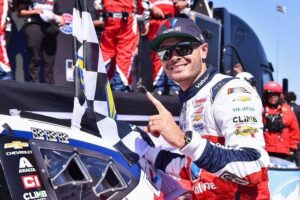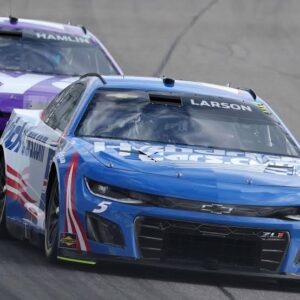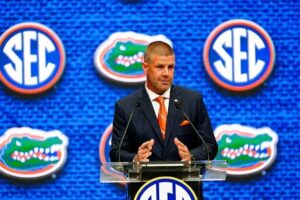
Kyle Larson’s focus on safety reflects a broader commitment within NASCAR to prioritize driver well-being.

Kyle Larson, a prominent driver in the NASCAR Cup Series, has been in the spotlight recently not only for his impressive performances on the track but also for his commitment to enhancing safety within the sport. After a stunning victory at the Bristol Motor Speedway, Larson took the opportunity to discuss the latest safety innovations in NASCAR and their impact on drivers’ well-being.
A Victory and a Platform
Larson’s win at the Bristol Motor Speedway was a testament to his skill and determination. However, beyond the thrill of victory, Larson used his media time to highlight a crucial aspect of modern racing: safety. In an era where high-speed crashes can have severe consequences, Larson’s focus on safety reflects a broader trend within NASCAR towards prioritizing driver protection.
Evolution of Safety Measures
NASCAR has made significant strides in safety over the years, with advancements in car design, protective gear, and track safety measures. Larson emphasized that the development of the Next Gen car, which debuted in 2022, represents a major leap forward in this area. The car features a redesigned chassis, enhanced crash protection, and improved safety cells that are designed to better absorb and distribute energy during a collision.
“The Next Gen car is a game-changer,” Larson said. “The improvements in safety technology have made a huge difference. The new chassis and the way the car is built to handle impacts give us, as drivers, more confidence when we’re out there pushing the limits.”
Innovations in Helmets and HANS Devices
In addition to advancements in car design, Larson discussed the role of personal safety equipment, particularly helmets and HANS (Head and Neck Support) devices. These technologies have evolved considerably, providing drivers with better protection against head and neck injuries. Larson noted that ongoing improvements in helmet technology, such as enhanced materials and better impact absorption, contribute significantly to driver safety.
“The helmets we have today are far superior to what we had a decade ago,” Larson explained. “They’re not just more comfortable, but they offer better protection. The same goes for the HANS devices. These innovations are crucial because they help protect us from injuries that were once much more common.”
Track Safety Enhancements
Track safety is another critical area where NASCAR has invested heavily. Larson highlighted recent improvements in track barriers, such as the SAFER (Steel and Foam Energy Reduction) barriers, which are designed to absorb and dissipate crash energy more effectively. These barriers have become standard at many tracks, significantly reducing the severity of impacts during crashes.
“SAFER barriers have been a huge step forward,” Larson noted. “They’ve changed the way tracks handle impacts and have made a big difference in reducing the risk of serious injuries. It’s comforting to know that tracks are continuously working to improve safety for everyone involved.”
The Role of Data and Technology
Larson also touched on how data and technology are used to enhance safety. NASCAR teams now have access to sophisticated telemetry and data analysis tools that help in understanding the forces involved in crashes and how cars perform under extreme conditions. This data is crucial for engineers and safety experts to make informed decisions about car design and safety features.
“Having access to real-time data allows us to better understand what happens during a crash,” Larson said. “Teams and NASCAR use this information to continuously refine safety measures, which is vital for keeping the sport as safe as possible.”
Looking Ahead
As NASCAR continues to evolve, Larson is optimistic about future safety innovations. He believes that ongoing research and development will bring even more advanced technologies to the sport, further enhancing driver protection. For Larson and his peers, these advancements are not just about improving performance but ensuring that they can compete with confidence knowing that their safety is a top priority.
“Innovation never stops,” Larson concluded. “We’re always looking for ways to make racing safer. The progress we’ve made so far is incredible, but there’s always more to be done. I’m excited to see where we go from here.”
Kyle Larson’s focus on safety reflects a broader commitment within NASCAR to prioritize driver well-being. As the sport continues to push boundaries, both on and off the track, the emphasis on safety remains a central theme in its evolution.







